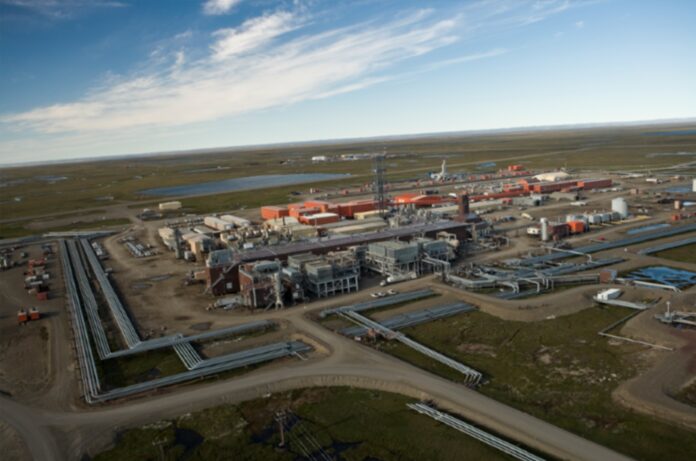ConocoPhillips Alaska has successfully delivered a single production module to drillsite 3T in the Kuparuk River Unit on Alaska’s North Slope. Earlier this summer, the module’s fabrication was completed as part of the Nuna major project at the Port of Alaska. The module then traveled by barge to Oliktok Dock where it was moved to its permanent location at drillsite 3T.
This is the first sea-lifted production module fabricated in Alaska for the company in more than two decades. Since January 2024, company investments in Alaska projects have exceeded $1.4 billion, lengthening the commitment to Alaska that ConocoPhillips has had for more than five decades.
During a ribbon cutting this summer, Erec Isaacson, President, ConocoPhillips Alaska, spoke about the module.
“It’s great to see the fabrication of the module take place right here in our backyard and be built by Alaskans,” he said. Nuna will bring Kuparuk’s 49th drillsite online and will add 29 development wells that tie back to existing processing facilities at Central Processing Facility 3. Nuna is projected to boost Kuparuk’s production in the coming years, reaching a peak rate of 20,000 net barrels of oil equivalent per day.
“Kuparuk has played a vital role in our company’s success, contributing significant production for more than 40 years,” Isaacson said. “It’s remarkable to witness new developments like the Nuna project showcasing that this asset remains robust and continues to provide considerable value to our North Slope operations.”
The site just east of the Colville River was explored by Pioneer Natural Resources, and oil was discovered in 2012. In 2019, ConocoPhillips Alaska acquired the 11 tracts over 21,000 acres, which by then included a gravel road and pad. In 2023, the company announced it would proceed with development.

More of this!
Not much information for such a large and important project. How many tons? How many men? How long did it take? How much did it cost? Who exactly was the builder? Did they have to hire outside, or was all of the labor Alaskan? Who did the sealift? More click bait is not what we need.
You know how to miss the point! How about when is first oil? Is the peak rate really 20,000 a day of is that a low number?
Reads like a paid advertisement promoting ConocoPhillips . With out ConocoPhillips , the other explorers on State land are going to add 500,000 barrels of oil throughput each and every day . This will double the size of the permanent fund . That’s real news in my mind . Not much mention of it in any newspaper in Alaska . Most Alaskans are misinformed by the newspapers .
Be real good idea to write and article mentioning this . In other words , get off your butts and write an article about NorthSlope oil production going up to near a million barrels a day in the next forty months .
More that likely billions of dollars in repairs and upgrades to the Trans Alaska Pipeline in the next few years . ( that’s the 48 inch pipeline that crosses Alaska North to south ) .
The only thing that Mary Pertola and her handlers had to do with this is the fact shutting oil drilling down on Federal lands and pushing investment to state of Alaska lands . This is where the additional 500,000 barrels of oil is going to be produced from .
Most Alaskans are outright lied to by the “newspapers”.
I’m still wondering what natural gas drilling in Alaska is going to replace Cook Inlet losses so we have more natural gas to heat our homes here in Southcentral. Last I read, Enstar’s out of gas by 2026.
Actually it’s quite impressive. Conoco’s Milne Point unit was delivered by sea lift in 1985. All modules were produced in Everett, WA or Oakland.
Great article SD! Still, despite the egregious – onerous bureaucratic morass we experience on a daily basis, COPA continues to make critical investments into AK907.
Realist, pardon me for having my own questions, my bad. As for production numbers, 20,000 bbl. Per day is ok. But remember oil in TAP peaked in 1988 @ 2.1 mil. bbl per day. It is now running maybe 485,000 per day. It is not unheard of for a drill site to under perform predicted output. Many things can go wrong, like the modular sinking because of heat produced by oil as it come up. Or erosion of piping due to sand in the oil. The wells them selves can sink as well. Risky investment. For the producer, for the State, not so much. Other drill sites are declining in production, so in the big picture this is really small beans. And they could turn mouldy.